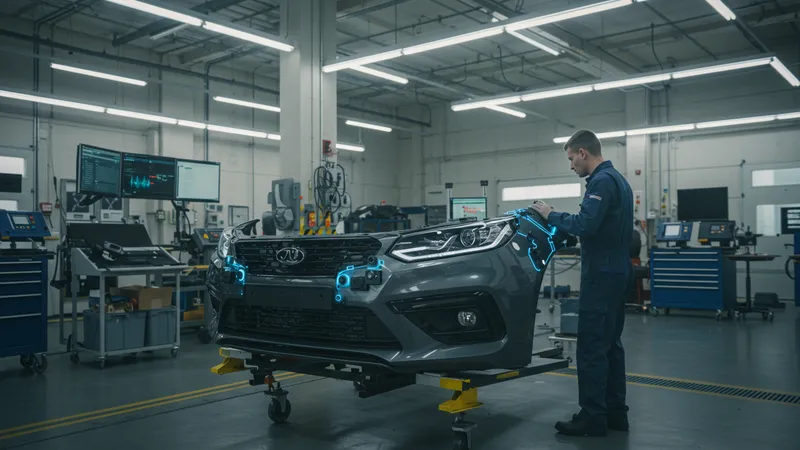

Did you know that the home and auto insurance market is undergoing a transformation that could affect your pocketbook? As new technologies and unexpected players enter the scene, understanding this shift is crucial.
This topic has never been more relevant! With economic uncertainties and climate change impacting insurance claims, staying informed could save you hundreds or even thousands of dollars annually.

The emergence of AI tools in insurance is raising eyebrows. These tools aren’t just number-crunching algorithms; they are redefining risk assessments by absorbing massive amounts of data in real-time. While traditional agents may struggle to keep up, AI systems offer precise, instant analysis. But that’s not even the wildest part…
Additionally, some companies are using drones to assess property damage—offering faster, more accurate evaluations of claims. Imagine a world where your roof damage can be judged without anyone climbing a ladder! But what’s causing an uproar is not the technology itself…
What happens next shocked even the experts. Major insurers are partnering with unconventional allies to transform the industry, and the implications for your premiums could be monumental. You won't believe who's stepping into the spotlight in this unexpected twist…
While traditional insurers have dominated the market for decades, tech giants like Amazon and Google are quietly making their entrance. By leveraging their data-gathering prowess, these companies aim to revolutionize how policies are priced and sold. The potential to tap into vast consumer data, like spending habits and search queries, offers new insights into risk assessment.

Amazon has already dipped its toes into offering home insurance by partnering with established firms. The result? Combos that promise better rates due to sophisticated risk analysis. The smart devices you use every day may soon play a role in determining your premiums, offering personalized discounts and alerts. But there’s one more twist…
Google, with its immense access to data analytics, has been developing tools to predict weather-related risks more accurately. This capability offers insurers a chance to manage claims more efficiently and set premiums that reflect real-time conditions. What you read next might change how you see this forever.
The shift towards data-driven insurance policies raises ethical questions about privacy. As big tech and insurers collaborate, concerns about data misuse loom large. What if the information tracked by your smart home could increase rates overnight? The implications extend beyond just financial to fundamental questions about privacy and control.
The days of one-size-fits-all insurance plans are numbered. In today's world, customizable packages are swiftly gaining traction. This innovation allows policyholders to tailor coverage to their individual needs, potentially reducing unnecessary costs. The appeal is clear: why pay for coverage you don't need?

Many insurers now offer modular plans, where customers can pick and choose coverage elements. For example, if your vehicle is rarely used, you might opt for reduced mileage coverage, leading to significant savings. These plans are especially popular among millennials who demand flexibility and transparency in their purchases.
Insurers are also exploring pay-per-use models, particularly in auto insurance. These plans track vehicle usage and adjust rates accordingly. It's a perfect solution for occasional drivers, creating fairness in pricing models. But it’s the hidden costs that families should be wary of…
While the benefits are clear, the fine print of these customizable packages often conceals potential pitfalls like premium adjustments. As more families consider these options, understanding their components becomes vital to avoid unexpected costs. The way families insure their homes and vehicles could be on a precipice of change.
It's undeniable—climate change is dramatically altering the insurance landscape. Natural disasters are becoming more frequent and severe, driving up claims at an unprecedented rate. This phenomenon has led insurers to reconsider how they assess and price risks.

Regions prone to hurricanes, floods, or wildfires are witnessing a surge in insurance premiums. Some companies are even opting out of high-risk areas entirely. For homeowners, this shift could mean exploring alternative solutions or fortified protective measures to remain insurable.
The ripple effect is global. Countries around the world are adapting policies to manage burgeoning claim costs. Climate models are being integrated into insurance algorithms, offering predictive insights to safeguard both insurers and customers. But there’s another undercurrent affecting this upheaval…
Many argue that insurers are not doing enough to account for climate resilience or support genuine sustainability efforts in construction. The need for a long-term view on this challenge becomes clear when considering the future of homes and communities. The next revelation might just rewrite the insurance rulebook.
In insurance, it’s often the hidden costs that blindside policyholders. One might think they are thoroughly covered, yet small clauses can lead to substantial out-of-pocket expenses. These hidden costs are frequently buried deep within policy documents, written in legal jargon that is difficult for the untrained eye to decipher.

Insurance companies gain significantly from these obscured costs, often saving millions annually. Consider rising deductibles and additional fees that can come as a shock at the time of a claim. Slate-grey areas of coverage conditions might also limit claims unexpectedly.
For those unaware, these hidden details can lead to bitter surprises when making claims. Partnering with a seasoned broker to navigate your policy can uncover and mitigate many of these pitfalls. But a deeper issue lies within the payout structure itself…
It's not just fine print and additional fees. The very structure of how insurers calculate risk and rates means consumers are often paying more than necessary. Reassessing and recalibrating policies to fit modern needs might just be the industry’s next major shift—a concept that's only just beginning to gather momentum.
Over the past decade, insurance premiums have climbed steadily. Factors contributing to this surge include escalating repair costs, increased accident rates, and emerging liabilities associated with climate change. But there's a lesser-known catalyst driving these costs behind the scenes.

As vehicles become more technologically advanced, repair costs have skyrocketed. A simple bumper fix now involves high-tech sensors and cameras, turning minor repairs into costly expenditures. This complexity has inevitably contributed to rising insurance costs.
The downward pressure on premiums is also impacted by fraud. Insurers combat significant losses from fraudulent claims annually, compelling companies to raise rates across the board. But that’s not the only element squeezing consumers' wallets…
Legislative changes and regulatory requirements are increasingly burdening insurers, driving operational costs up. As these financial burdens pass onto consumers, it’s a trend worth monitoring. Understanding these components could empower policyholders to seek fairer, more sustainable premiums.
The insurance industry is gradually shifting towards a paperless future, driven by technological advancements and environmental concerns. Digital policies and claims processing are reducing paperwork, offering convenience and efficiency to both insurers and policyholders alike.

This shift has financial incentives as well. Reduced administrative costs mean potential savings can be passed on to the consumers. But in an age full of cyber threats, a predominantly digital approach also raises concerns about data security and privacy.
Many companies are already investing in cybersecurity measures to protect sensitive information. However, consumers must stay vigilant, understanding how their data is used and protected. What this means for the traditional insurance advisor may surprise you…
With the rise of digital interface, personal touchpoints like face-to-face consultations are dwindling. This evolution signals a transformation in client relations, necessitating a new set of skills for maintaining customer loyalty and trust in a virtual world. The next tech trend heralds yet another leap forward for the industry.
Blockchain technology has stealthily infiltrated the insurance industry, offering a slew of benefits, from enhanced transparency to fraud reduction. This decentralized ledger system helps track transactions while maintaining high security and visibility.

One key advantage is the reduction of fraud. Blockchain offers a secure, immutable record of transactions, making it near impossible to tamper with. This technology promises significant savings for insurers, which could eventually trickle down to consumers.
Moreover, blockchain platforms facilitate faster and more transparent handling of claims, reducing administrative burdens and waiting times. The automation of smart contracts ensures quick, reliable payouts. There's yet another unexpected advantage that blockchain delivers…
Interoperability across borders becomes seamless with blockchain. The global insurance market can leverage this technology to ensure uniformity in policy enforcement and claims settlements. This could pave the way for a truly international insurance landscape, free of geographical constraints or traditional systemic delays.
With cyber threats on the rise, cyber insurance has emerged as a crucial component of risk management for businesses and individuals alike. As cyber incidents become more frequent, having a solid insurance plan is no longer a luxury, but a necessity.

Cyber insurance provides coverage for losses stemming from data breaches, ransomware attacks, and other cyber threats. As vulnerabilities continue to evolve, insurers are rapidly adapting, offering more comprehensive solutions tailored to specific industries or individual needs.
The cost of cyber insurance varies widely based on coverage levels, complexity, and risk exposure. Companies seeking the most robust defense often go through a meticulous assessment process. Yet, it’s the added layer of protection that beckons even more consideration…
As remote work becomes a staple, personal and professional boundaries blur, increasing demands for coverage at both levels. The future landscape of cyber insurance will likely involve sophisticated, adaptive models to keep pace with ever-changing threats, challenging traditional policy frameworks along the way.
Ride-sharing has exploded into the mainstream, prompting new insurance products designed to cater specifically to this dynamic sector. As Uber and Lyft expand, unique coverage requirements arise to protect drivers and passengers alike.

Unlike traditional auto policies, ride-sharing insurance plugs gaps often not covered by personal or commercial auto policies. Whether it's covering accidents while en route to pick up passengers or liability claims during rides, these policies offer extensive, specialized protection.
Pricing varies based on vehicle type, mileage, and other factors, with insurers scrambling to tailor packages to fit diverse needs. Insurers are keen to attract ride-share drivers, offering competitive rates and policy perks. But one oversight could still leave you unprotected…
Understanding the line between personal and commercial use is essential to ensure coverage kicks in when needed. Drivers must be well-versed in their policy terms and premiums to avoid lapses during a claim. Navigating this niche is set to become even more critical as ride-sharing platforms diversify.
In a world where sharing economies are flourishing, peer-to-peer (P2P) insurance emerges as an intriguing alternative model. With principles rooted in collaboration and shared risk, P2P insurance has the potential to disrupt traditional insurance paradigms.

By grouping individuals with similar coverage needs, P2P insurance aims to reduce costs and eliminate inefficiencies. Policyholders pool premiums to cover claims, promoting transparency and fostering trust among members. This close-knit approach offers a refreshing change, but there’s an element shrouded in mystery…
Large insurers have taken note, experimenting with P2P elements to enhance customer engagement and retention. Incentives for low claim incidents and healthy lifestyles flourished within these systems, encouraging responsible behavior among peers. What remains hidden is the potential for conflict or dissatisfaction should claim behaviors shift unexpectedly.
As more participants join this insurance innovation, the delicate balance between sustainability and fair distribution remains to be seen. There’s still much to uncover in refining this model for broader acceptance and maximizing benefits for all parties involved.
Telematics is turning heads in the auto insurance sector, introducing new frontiers in coverage through data collection. By monitoring driving behaviors via GPS or on-board diagnostic systems, insurers can tailor premiums to match actual usage.

For cautious drivers who maintain low risk profiles, this data-driven approach offers significant savings, ensuring that policyholders only pay for what they use. The promise of fairer prices entices many to adopt telematics-based policies, alluding to broader financial impact.
However, the detailed tracking and potential privacy implications leave some wary. The fine line between efficiency and surveillance creates a divide, challenging insurers to protect consumer interests without sacrificing innovation. Yet, there’s a greater revelation unfolding…
Industry experts predict that telematics will soon evolve beyond just personal vehicles, potentially revolutionizing commercial fleet insurance as well. Such expansion could redefine operational efficiencies, cutting costs and streamlining logistics for businesses worldwide. The implications reach far beyond what was initially imagined.
As cryptocurrency enters the mainstream, insurers are exploring ways to integrate digital currencies into policies and claims. From paying premiums in Bitcoin to insuring crypto assets, the possibilities are as vast as they are complicated.

Cryptocurrency's volatile nature presents both opportunities and challenges. Insurers tread cautiously, developing products to safeguard investments against hacking or market fluctuations. This speculative frontier opens doors to a unique clientele, but also threatens traditional paradigms with uncertainty.
Nonetheless, embracing blockchain's security potential offers a remarkable advantage. By adhering to transparent, immutable records, insurers can mitigate fraud risks, enhancing trust within the cryptosphere. There's an unforeseen consequence accompanying this evolution…
Regulatory landscapes remain unclear, posing hurdles for insurers in fully embracing cryptocurrencies. As progress continues, the interplay between digital currencies and insurance could signal the onset of regulatory change, ushering in a new era of products and practices tailored to modern financial ecosystems.
As the insurance industry embraces technology and innovation, ethical challenges loom larger than ever. These issues range from privacy incursions in data collection to ensuring equitable access to products and services across diverse demographics.

Discrimination concerns arise as algorithms increasingly influence coverage decisions. Ensuring these systems remain unbiased and transparent requires vigilant oversight and regulation. The lack of education on technology among consumers may exacerbate these divides.
Moreover, sustainable practices foster questions about social responsibilities. Can insurers balance profit with promoting environmental and social good? Navigating these moral avenues might redefine future industry standards. There's a critical juncture on the horizon…
Insurers will need to decide whether technological advancements will drive division or unity. As the balance tips, the industry’s future will inevitably reflect the choices made today, determining the happiness, health, and safety of policyholders everywhere.
The future of home and auto insurance is poised for dramatic change, with emerging technologies and forces reshaping the landscape at breakneck speed. Whether it’s blockchain or AI, each innovation bears its challenges and opportunities.
This transformative wave beckons consumers to stay informed and proactive. By understanding these shifts, individuals and businesses can make more informed decisions, ensuring they aren’t left behind. Share these insights, bookmark this article, and prepare for the changes afoot!